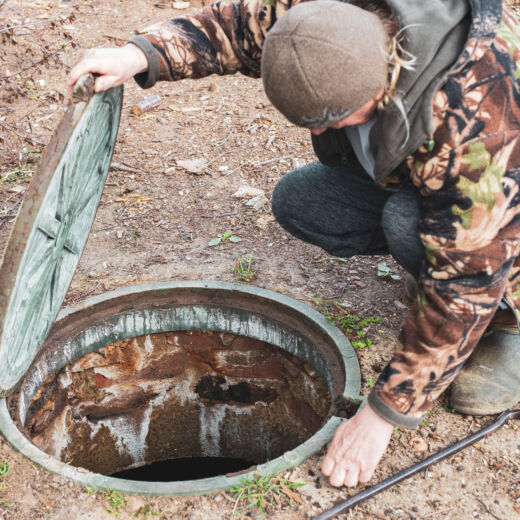There are many different types of septic systems. The one you have will greatly impact how your maintenance and inspections are performed. Knowing what type of septic system is installed in your home is important, as you’ll be able to tell if something is wrong with your specific septic systems.
There are three main types of septic systems:
- Mounds and Fields
- Sand Filters
- At-Grades
Here is some information about the different types of septic systems and their components, maintenance, and filtration.
What are the Different Types of Septic Systems?
Mounds and Fields
Mounds and Fields, though two separate types of septic systems, are often grouped together because they operate essentially the same. Their only difference is that they vary in appearance and in the construction of the final treatment area. Field septic systems are typically flat and lay at or below the surface. Many refer to fields as a “conventional system,” which means that the home sends effluent into a standard two-chamber septic tank where solids settle in the first chamber and a clarified liquid passes to the second chamber where it is sent by a pump or by gravity to final treatment in the soil. Field systems tend to last 20-25 years. Mounds, on the other hand, sit slightly above the surface where the final treatment occurs. Theoretically, mounds should last about the same as fields, but in practice we find they tend to last more in the range of 15-20 years before organics build up and leaks at the toe or a surface breach at the top starts to form.
Sand Filters
Sand filters are a form of secondary/advanced treatment to produce a higher quality effluent that allows the effluent to be discharged to a smaller field, smaller mound, or an at-grade for final treatment. We find these septic systems tend to have about an 8-10 year lifespan before the sand filter gets clogged with organics and biomat, often requiring replacement/rebedding by the installer at significant cost
At-Grades
At-grades are the newest and, lately, the most-common type of septic system construction. At-grades are typically constructed on the surface of the property, usually in treed areas, then covered with wood chips to add a layer of insulation and to help them blend back into the environment. These systems always require advanced/secondary treatment to create a very high-quality effluent that is safe to be reintroduced to the environment. All advanced treatment/secondary treatment systems require ongoing, annual maintenance to ensure proper effluent quality is being returned to the environment. Sand filters can be one form of treatment upstream of an at-grade, as can competitor’s packaged sewage treatment plants, and our SludgeHammer NSF-certified S400, S600 and S1000 models.
Maintaining Your Septic System
Depending on the type of septic system you have, different maintenance requirements are in place. Alberta Standards Of Practice (SOP) requires that secondary treatment/advanced treatment systems/“Packaged Sewage Treatment Plants” must be maintained by certified techs every year. This is because these systems allow for discharge of effluent into smaller drainfields that are often closer to or actually on the surface, compared to conventional systems. As such, they need to be maintained or the effluent quality goes down and they fall outside of their operating specs, causing health and environmental safety concerns. It’s still a good idea to get even conventional systems inspected annually, as this allows for any issues to be addressed early on. Typically, most maintenance costs $500-$1000/year for maintenance either annually or every 4-6 months as determined by their design, usage, etc. SludgeHammer systems cost half that amount (or less) at $250/year for annual system maintenance.
Components of a Septic System
All septic systems consist of a septic tank having 2 or more chambers, a delivery system (usually a pump, but can be gravity fed depending on the installation), and a drainfield of some sort. The drainfield can be a septic field, a mound, or at-grade. Septic fields are flat and the least noticeable in most yards. Mounds are essentially a septic field, but constructed above the ground and providing the layers of the specific type(s) of soils required to properly filter effluent before it is introduced into the environment. At-grades are essentially a septic field suspended above the ground in a treed/wooded area, then often covered with wood chips for insulation and to allow nature to reclaim that area and have it “blend in” with the surroundings.
At-grade systems tend to be typically the smallest in terms of footprint, as they are always fed the highest quality of effluent possible and therefore don’t require the same amount of square footage to disperse and filter effluent before it is reintroduced into the environment. Mounds and fields can also be fed with post-secondary treated effluent and can in those cases, be constructed smaller than a conventional field or mound.
A final component in all modern septic systems is they are required to have an septic alarm indicating when problems occur and levels in the tank go beyond normal operating ranges. Although older systems may not be required to have an alarm, there is no good reason not to have one. The cost of them is more than offset by the opportunity to avoid a messy backup into the home.
Septic System Failures
All components of septic systems are ultimately prone to failure. The system’s pumps, floats, and alarms are electronic and ultimately have a life cycle. Delivery lines can become disconnected, broken, pinched, or kinked, and they may be prone to freezing if the right conditions are present.
Septic tanks eventually break down and the integrity of their baffles, walls, risers, covers/lids or other internal components may eventually fail as well. This could result in lower quality effluent being sent to drainfields which is a bio hazard and can lead to your drainfield failing. If the septic system components deteriorate too far, it could also cause the drainfield to collapse and cause serious safety issues, such as sinkholes.
Failures of drainfields typically present themselves as wet spots, surface breaches, or puddles of effluent ponding on the surface, or even flowing away due to changes in landscaping and elevation. This is a health and environmental risk, and often homeowners are told that replacement of their entire system is the only solution. This is not the case anymore, as the government has tested and approved of remediation systems like the processes SepTech Canada uses to restore function. Our drainfield restoration services can prevent costly replacement of the entire system.
In almost all cases, remediation and repair is possible, but an on-site assessment must be made to see if the system qualifies and is in good enough condition to be repaired. If left too-long, damage can be unrecoverable and the ability to repair or remediate is lost. Septic systems cannot and will not “heal themselves”, so it is always recommended to have an assessment done sooner rather than later and provide every opportunity for homeowners to repair their septic systems instead of being forced to replace everything.
If your septic system is starting to fail, Ignoring the problem isn’t an option. The fines along for surfacing effluent on residential properties are typically $50,000 and up, and leaving the problem will only make things for your property worse. Improper filtration of effluent is something provincial and federal governments take very seriously ?— especially in residential areas where pets and children may find themselves coming across nasty surprises in the bush or in the back yards, and contamination gets tracked into homes compounding the health and safety risks.
What to Do if Your Septic System Fails?
If you’re noticing signs that your drainfield is failing, the first thing you should do is call SepTech Canada! We have a 24/7 live answer guarantee, and we’ll ensure that we book an on-site assessment of your current system within 24 hours. The technology we use to repair and replace septic drainfields has been used in Canada since 2005, and with this technology we have a lifetime warranty on your septic drainfield! Our technology for repairing septic systems can save you tens of thousands of dollars in replacement costs or even fines. If your drainfield is showing signs of failure, or you just want a check up of your system, contact us today!




